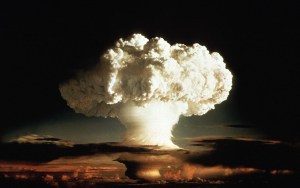
A mushroom cloud
On Feb. 25, I posted a blog arguing that nuclear weapons are the most important and urgent environmental threat today—even more important than climate change caused by greenhouse gasses. I received quite a bit of feedback from environmentalists—many of whom took umbrage with my thesis.
Interestingly, no one argued that the predictions of climate change following a limited nuclear war (50-100 Hiroshima-sized bombs) was unsound—after all, scientists use some of the same climate modeling techniques to predict the global cooling from nuclear fallout and soot as they use to chart the future of global warming from carbon emissions and other greenhouse gases. Many environmentalists felt simply that the chances of nuclear war were so small that worrying about its effect on the climate was a waste of time. Joe Romm’s sentiments on the Climate Progress blog were typical: “So the scenario being offered is that some accident or other event leads to India and Pakistan suicidally using most of their nuclear weapons on each other. Something to worry about? Absolutely. Likely? Not terribly. Preventable through the political efforts of U.S. environmentalists? Gimme a break!”
In a way, Romm’s exasperation is understandable. The problem with estimating the nuclear threat is that the risk of nuclear war is simply not known. All we know for sure is that nuclear deterrence has successfully avoided a nuclear war for 65 years. To Romm and many others, including my colleague here at TIME David von Drehle, this success strongly suggests that nuclear weapons are safe.
This thinking is highly dangerous and is based on a fallacy. And environmentalists, of all people, should know better. Consider the Deepwater Horizon disaster. In an article titled “How Risky Is Nuclear Optimism” in the latest edition of the arms control magazine The Bulletin of the Atomic Scientist, Martin Hellman, a Professor Emeritus of electrical engineering at Stanford University, points out that in November 2009, BP’s vice president for exploration in the Gulf of Mexico, David Rainy, succumbed to just this sort of erroneous logic. Hellman quotes Rainy’s testimony before a Congressional Committee: “I think we also need to remember that OCS [Outer Continental Shelf] development has been going on for the last 50 years, and it has been going on in a way that is both safe and protective of the environment.”
Of course, five months later BP’s Deepwater Horizon drilling rig created an environmental catastrophe. Hellman writes: “Fifty years of success was inadequate evidence for complacency.”
A similar situation preceded the Space Shuttle Challenger disaster, Hellman points out. Concerns by some shuttle engineers over the integrity of “O-ring gaskets” were overruled by senior managers, who cited the success of 24 previous missions.
The moral of the story is that humans have a tendency to misunderstand the laws of probability and risk. Don’t believe me? In a separate article on his arms control blog “Nuclearrisk.org,” Hellman shows how easy it is to overestimate the safety of low-probability events. Referring to stunt show maneuvers performed by glider pilots, Hellman says crash evidence suggests these manoeuvres are 99.9% safe. Sounds fine, right? But not when Hellman points out that “If a pilot does a 99.9% safe maneuver 100 times, he stands roughly a 10% chance of being killed.”
Similarly, if we assume that nuclear deterrence has a failure rate each year of 1 in 1000—that is to say, that nuclear weapons will only be exchanged once each millennium, a reasonably conservative estimate—then a child born today with a 78-year life expectancy would have a 7.5% chance of living through a nuclear war. That’s clearly not an acceptable level of risk given the catastrophic consequences of such an event.
(Quick math notes: Probability of a 1 in 1000 occurrence in 78 years = .999 to the power of 78 = 92.5%=7.5%)
The problem with nuclear optimism is that it is based on intuition. But intuitions are often filled with biases and other failures of human thought. Environmentalists who don’t see atomic bombs as a green issue look back over more than a half century of (relative) world peace and assume that nuclear weapons are safe. But we don’t know that to be the case with any acceptable level of certainty. So I repeat my original request. Environmentalists: Wake Up! Nuclear disarmament should be your most urgent green issue.
(More on Time.com: See Pictures of Hiroshima)


